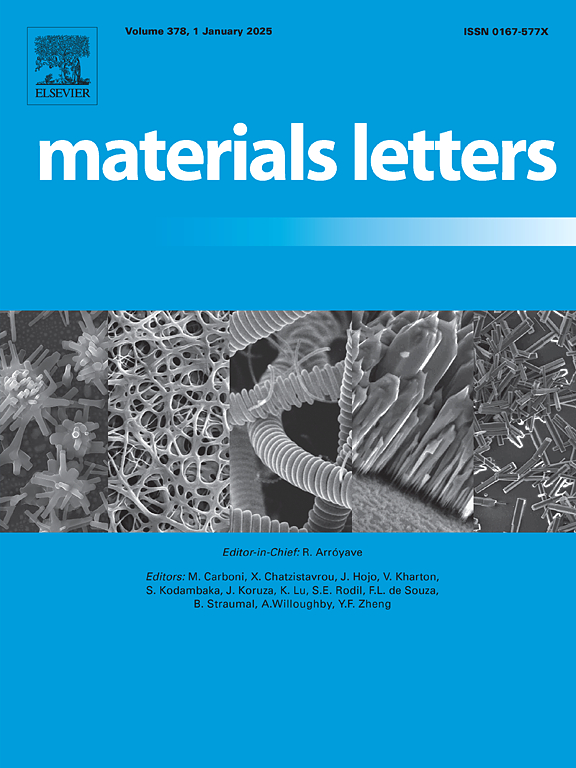Enhanced corrosion inhibition of mild steel in concrete pore solution using modified mgo-chitosan epoxy nanocomposite coatings
IF 2.7
4区 材料科学
Q3 MATERIALS SCIENCE, MULTIDISCIPLINARY
引用次数: 0
Abstract
In this study, epoxy-based coatings (pure epoxy, MgO-modified, chitosan-modified, and MgO-chitosan nanocomposite) were applied to polished mild steel in a simulated concrete pore solution. The coatings were formulated by dispersing MgO nanoparticles and chitosan into an epoxy resin, homogenised by stirring, applied via the glass slide method, and cured. Electrochemical analysis (open-circuit potential, Nyquist, and Tafel plots) demonstrated the superior performance of the nanocomposite, which exhibited the highest charge-transfer resistance and lowest corrosion current density (Icorr = 2.076 × 10 − 4). Weight loss tests confirmed a 93.53 % inhibition efficiency, outperforming the uncoated steel and single-additive systems. FESEM morphological analysis revealed a uniform, porous nanocomposite structure with well-dispersed nanoparticles and minimal post-exposure cracking, in contrast to the severe pitting observed in the uncoated specimens. Elemental mapping confirmed MgO-chitosan integration and limited chloride penetration. The synergy between MgO and chitosan validates this hybrid organic–inorganic coating as an effective corrosion mitigation strategy for steel in chloride based alkaline concrete environments.
改性镁壳聚糖环氧纳米复合涂层增强低碳钢在混凝土孔隙溶液中的缓蚀性能
在本研究中,将环氧基涂料(纯环氧树脂、氧化镁改性、壳聚糖改性和氧化镁-壳聚糖纳米复合材料)应用于模拟混凝土孔溶液中抛光的低碳钢。涂层是通过将氧化镁纳米颗粒和壳聚糖分散到环氧树脂中,通过搅拌均匀,通过玻片法涂敷,并固化而成的。电化学分析(开路电位、Nyquist和Tafel图)表明,该纳米复合材料具有最高的电荷转移电阻和最低的腐蚀电流密度(Icorr = 2.076 × 10−4)。减重试验证实了93.53%的缓蚀效率,优于未涂层钢和单一添加剂体系。FESEM形态分析显示,与未涂层样品中观察到的严重点蚀相比,涂层样品具有均匀、多孔的纳米复合材料结构,纳米颗粒分散良好,暴露后开裂最小。元素映射证实了氧化镁-壳聚糖的整合和有限的氯化物渗透。MgO和壳聚糖之间的协同作用验证了这种混合有机-无机涂层作为氯基碱性混凝土环境中钢的有效缓蚀策略。
本文章由计算机程序翻译,如有差异,请以英文原文为准。
求助全文
约1分钟内获得全文
求助全文
来源期刊

Materials Letters
工程技术-材料科学:综合
CiteScore
5.60
自引率
3.30%
发文量
1948
审稿时长
50 days
期刊介绍:
Materials Letters has an open access mirror journal Materials Letters: X, sharing the same aims and scope, editorial team, submission system and rigorous peer review.
Materials Letters is dedicated to publishing novel, cutting edge reports of broad interest to the materials community. The journal provides a forum for materials scientists and engineers, physicists, and chemists to rapidly communicate on the most important topics in the field of materials.
Contributions include, but are not limited to, a variety of topics such as:
• Materials - Metals and alloys, amorphous solids, ceramics, composites, polymers, semiconductors
• Applications - Structural, opto-electronic, magnetic, medical, MEMS, sensors, smart
• Characterization - Analytical, microscopy, scanning probes, nanoscopic, optical, electrical, magnetic, acoustic, spectroscopic, diffraction
• Novel Materials - Micro and nanostructures (nanowires, nanotubes, nanoparticles), nanocomposites, thin films, superlattices, quantum dots.
• Processing - Crystal growth, thin film processing, sol-gel processing, mechanical processing, assembly, nanocrystalline processing.
• Properties - Mechanical, magnetic, optical, electrical, ferroelectric, thermal, interfacial, transport, thermodynamic
• Synthesis - Quenching, solid state, solidification, solution synthesis, vapor deposition, high pressure, explosive
 求助内容:
求助内容: 应助结果提醒方式:
应助结果提醒方式:


